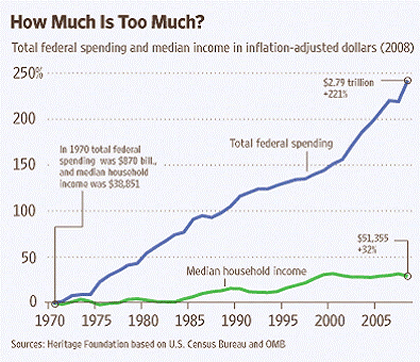Results 1 to 1 of 1
Thread Information
Users Browsing this Thread
There are currently 1 users browsing this thread. (0 members and 1 guests)
-
04-01-2010, 07:49 PM #1Senior Member


- Join Date
- May 2007
- Location
- South West Florida (Behind friendly lines but still in Occupied Territory)
- Posts
- 117,696
U.S. Debt–to-GDP Situation, When Will the Dominos Align
U.S. Debt–to-GDP Situation, When Will the Dominos Align
Economics / US Debt
Apr 01, 2010 - 12:49 PM
By: Hans_Wagner
In February 19, 2010 Wall Street Journal, Daniel Henninger included the following chart in his column. Federal spending has grown seven times the real median household income over the last 40 years. At some point, the government will be unable to pay for all the new programs, stimulus, healthcare, rapid expansion in number of government employees, etc. The market will drive up the cost of debt to levels that lead to default. Many say it cannot happen to the U.S.

There is a lot of truth in that claim. After all, the U.S. treasuries have seen substantial buying interest as concern over the Greek credit crisis grew more worrisome, lending credence to those that claim the U.S. remains strong despite the growing deficits. But where is the break point?
Debt-to-GDP Threshold
In a paper by Carmen Reinhart and Ken Rogoff, the authors of This Time Its Different found that when the government debt-to-GDP ratio rises above 90%, it lowers the future potential GDP of that country by more than 1%. It also locks in a slow-growth, high-unemployment economy. The authors point to history that shows that public debt tends to soar after a financial crisis, rising by an average of 86% in real terms. Defaults by sovereign entities often follow.
The current problems of Greece and Europe offer an example of what a country faces when their debt gets out of control.
Several countries, including Greece were allowed into the European Union with an exchange rate that many considered overvalued relative to the currencies of the larger more stable countries. This encouraged the Greek consumer to buy products that had been too expensive. Short term it helped the export driven economies of the larger European countries such as Germany.
After joining, the Greek government continued to spend beyond its means. The current Greek debt is now €254 billion and their GDP is €250.9 billion. The Greek debt to GDP ratio is 101.2%, greater than Reinhart and Rogoff’s threshold. The potential that Greece could fail is real, as they are unlikely to be able to fund this debt and future expenditures.
To receive a bailout, Greece is being asked to cut its budget to 8.7% of its deficit in 2010 and another 3% in each of the next three years. This is the equivalent of a $560 billion budget cut for the U.S. this year followed by further cuts of the same size in each of the following years.
U.S. Debt–to-GDP Situation
To put this into perspective the U.S. debt is $12.6 trillion and the 2009 GDP was $14.4 trillion or an 88% debt to GDP ratio. The Federal Reserve and other intergovernmental agencies such as the Social Security fund own approximately half of the U.S. Treasury debt.
With the U.S. running current budget deficits of $1.4 trillion that are expected to continue for several years, this ratio will rise. To quote the Congressional Budget Office (CBO), The Budget and Economic Outlook: Fiscal Years 2010 to 2020, dated January 2010:
“If the tax cuts were made permanent, the AMT was indexed for inflation, and annual appropriations kept pace with GDP, the deficit in 2020 would be nearly the same, historically large, share of GDP that it is today, and debt held by the public would equal nearly 100 percent of GDP�Join our efforts to Secure America's Borders and End Illegal Immigration by Joining ALIPAC's E-Mail Alerts network (CLICK HERE)


 LinkBack URL
LinkBack URL About LinkBacks
About LinkBacks




 Reply With Quote
Reply With Quote

PHOTOS: Biden�s Released Migrants Still Camp on Streets of El...
05-04-2024, 04:01 PM in illegal immigration News Stories & Reports